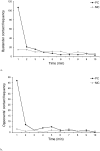Bonobos respond to distress in others: consolation across the age spectrum
- PMID: 23383110
- PMCID: PMC3559394
- DOI: 10.1371/journal.pone.0055206
Bonobos respond to distress in others: consolation across the age spectrum
Abstract
How animals respond to conflict provides key insights into the evolution of socio-cognitive and emotional capacities. Evidence from apes has shown that, after social conflicts, bystanders approach victims of aggression to offer stress-alleviating contact behavior, a phenomenon known as consolation. This other-orientated behavior depends on sensitivity to the other's emotional state, whereby the consoler acts to ameliorate the other's situation. We examined post-conflict interactions in bonobos (Pan paniscus) to identify the determinants of consolation and reconciliation. Thirty-six semi-free bonobos of all ages were observed at the Lola ya Bonobo Sanctuary, DR Congo, using standardized Post-conflict/Matched Control methods. Across age and sex classes, bonobos consoled victims and reconciled after conflicts using a suite of affiliative and socio-sexual behaviors including embracing, touching, and mounting. Juveniles were more likely to console than adults, challenging the assumption that comfort-giving rests on advanced cognitive mechanisms that emerge only with age. Mother-reared individuals were more likely to console than orphans, highlighting the role of rearing in emotional development. Consistent with previous studies, bystanders were more likely to console relatives or closely bonded partners. Effects of kinship, affiliation and rearing were similarly indicated in patterns of reconciliation. Nearby bystanders were significantly more likely to contact victims than more distal ones, and consolation was more likely in non-food contexts than during feeding. The results did not provide convincing evidence that bystander contacts served for self-protection or as substitutes for reconciliation. Overall, results indicate that a suite of social, developmental and contextual factors underlie consolation and reconciliation in bonobos and that a sensitivity to the emotions of others and the ability to provide appropriate consolatory behaviors emerges early in development.
Conflict of interest statement
Figures





References
-
- Aureli F, de Waal FBM (2000) Natural conflict resolution. Berkeley: University of California Press.
-
- Koski SE, Sterck EHM (2007) Triadic postconflict affiliation in captive chimpanzees: does consolation console? Anim Behav 73: 133–142.
-
- Cheney D, Seyfarth R (1989) Reconciliation and redirected aggression in vervet monkeys, Cercopithecus aethiops . Behaviour 110: 258–275.
-
- Judge PG (1991) Dyadic and triadic reconciliation in pigtail macaques (Macaca nemestrina). Am J Primatol 23: 225–237. - PubMed
Publication types
MeSH terms
LinkOut - more resources
Full Text Sources
Other Literature Sources

